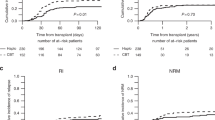Abstract
We analyzed the results of third allogeneic stem cell transplantation (SCT3) using single-unit unrelated cord blood (CB) in seven adult patients with relapsed acute leukemia after second allogeneic stem cell transplantation (SCT2). The median age at SCT 3 was 44 years (range 20–58 years). The patients had de novo acute myeloid leukemia (AML) (n = 4), secondary AML following myelodysplastic syndrome (n = 2), and acute lymphoblastic leukemia (n = 1). Four patients received myeloablative conditioning, and three received reduced-intensity conditioning. All but one patient had myeloid reconstitution with remission, but five patients relapsed even after SCT3. However, one patient is alive and disease-free 6 years after SCT3, which is the longest remission duration among three allogeneic SCTs she received. Furthermore, actual survival after relapse of SCT 2 was significantly better for patients who received SCT3 compared with institutional control patients who never received SCT3 (P < 0.001). These results suggest that the use of CB may allow the opportunity to perform SCT3 in patients who have experienced relapsed leukemia without donors, and SCT3 with CB may offer the chance of durable remission for selected patients with relapsed acute leukemia.

Similar content being viewed by others
References
Konuma T, Ooi J, Takahashi S, Tomonari A, Tsukada N, Kato S, et al. Second myeloablative allogeneic stem cell transplantation (SCT) using cord blood for leukemia relapsed after initial allogeneic SCT. Leuk Res. 2009;33:840–2.
Pawson R, Potter MN, Theocharous P, Lawler M, Garg M, Yin JA, et al. Treatment of relapse after allogeneic bone marrow transplantation with reduced intensity conditioning (FLAG ± Ida) and second allogeneic stem cell transplant. Br J Haematol. 2001;115:622–9.
Kedmi M, Resnick IB, Dray L, Aker M, Samuel S, Gesundheit B, et al. A retrospective review of the outcome after second or subsequent allogeneic transplantation. Biol Blood Marrow Transpl. 2009;15:483–9.
Hartwig M, Ocheni S, Asenova S, Wiedemann B, Zabelina T, Ayuk F, et al. Second allogeneic stem cell transplantation in myeloid malignancies. Acta Haematol. 2009;122:185–92.
Eapen M, Giralt SA, Horowitz MM, Klein JP, Wagner JE, Zhang MJ, et al. Second transplant for acute and chronic leukemia relapsing after first HLA-identical sibling transplant. Bone Marrow Transpl. 2004;34:721–7.
Radich JP, Sanders JE, Buckner CD, Martin PJ, Petersen FB, Bensinger W, et al. Second allogeneic marrow transplantation for patients with recurrent leukemia after initial transplant with total-body irradiation-containing regimens. J Clin Oncol. 1993;11:304–13.
Kishi K, Takahashi S, Gondo H, Shiobara S, Kanamaru A, Kato S, et al. Second allogeneic bone marrow transplantation for post-transplant leukemia relapse: results of a survey of 66 cases in 24 Japanese institutes. Bone Marrow Transpl. 1997;19:461–6.
Bosi A, Laszlo D, Labopin M, Reffeirs J, Michallet M, Gluckman E, et al. Second allogeneic bone marrow transplantation in acute leukemia: results of a survey by the European Cooperative Group for Blood and Marrow Transplantation. J Clin Oncol. 2001;19:3675–84.
Oda M, Isoyama K, Ito E, Inoue M, Tsuchida M, Kigasawa H, et al. Survival after cord blood transplantation from unrelated donor as a second hematopoietic stem cell transplantation for recurrent pediatric acute myeloid leukemia. Int J Hematol. 2009;89:374–82.
Schechter T, Avila L, Frangoul H, Domm J, Dupuis LL, Naithani R, et al. Effect of acute graft-versus-host disease on the outcome of second allogeneic hematopoietic stem cell transplant in children. Leuk Lymphoma. 2013;54:105–9.
Christopeit M, Kuss O, Finke J, Bacher U, Beelen DW, Bornhäuser M, et al. Second allograft for hematologic relapse of acute leukemia after first allogeneic stem-cell transplantation from related and unrelated donors: the role of donor change. J Clin Oncol. 2013;31:3259–71.
Duus JE, Stiff PJ, Choi J, Parthasarathy M, Rodriguez T, Toor AA. Second allografts for relapsed hematologic malignancies: feasibility of using a different donor. Bone Marrow Transpl. 2005;35:261–4.
Thakar MS, Forman SJ. ASH evidence-based guidelines: is there a role for second allogeneic transplant after relapse? Hematol Am Soc Hematol Educ Progr. 2009:414–418.
Ooi J. Cord blood transplantation in adults. Bone Marrow Transpl. 2009;44:661–6.
Takahashi S, Iseki T, Ooi J, Tomonari A, Takasugi K, Shimohakamada Y, et al. Single-institute comparative analysis of unrelated bone marrow transplantation and cord blood transplantation for adult patients with hematologic malignancies. Blood. 2004;104:3813–20.
Takahashi S, Ooi J, Tomonari A, Konuma T, Tsukada N, Oiwa-Monna M, et al. Comparative single-institute analysis of cord blood transplantation from unrelated donors with bone marrow or peripheral blood stem-cell transplants from related donors in adult patients with hematologic malignancies after myeloablative conditioning regimen. Blood. 2007;109:1322–30.
Konuma T, Kato S, Ooi J, Oiwa-Monna M, Kawamata T, Tojo A, et al. Comparable long-term outcome of unrelated cord blood transplantation with related bone marrow or peripheral blood stem cell transplantation in patients aged 45 years or older with hematologic malignancies after myeloablative conditioning. Biol Blood Marrow Transpl. 2014;20:1150–5.
Kanda Y. Investigation of the freely-available easy-to-use software “EZR” (Easy R) for medical statistics. Bone Marrow Transpl. 2013;48:452–8.
Sumi M, Hata S, Sato K, Fujikawa Y, Shimizu I, Ueki T, et al. Severe pulmonary toxoplasmosis mimicking viral pneumonitis after a third allogeneic stem cell transplantation in a man with acute lymphoblastic leukemia. Intern Med. 2012;51:2943–7.
Lee SY, Kurita N, Maie K, Seki M, Yokoyama Y, Suzukawa K, et al. Prolonged survival of a refractory acute myeloid leukemia patient after a third hematopoietic stem cell transplantation with umbilical cord blood following a second relapse. Case Rep Hematol. 2014;2014:918708.
Acknowledgments
The authors thank all of the physicians and staff at the hospital in this study. This work was supported in part by grants from the Kobayashi Foundation.
Conflict of interest
The authors declare no competing financial interests.
Author information
Authors and Affiliations
Corresponding author
About this article
Cite this article
Konuma, T., Kato, S., Ooi, J. et al. Third allogeneic stem cell transplantation (SCT) using unrelated cord blood for relapsed acute leukemia after second allogeneic SCT. Int J Hematol 101, 392–397 (2015). https://doi.org/10.1007/s12185-015-1755-7
Received:
Revised:
Accepted:
Published:
Issue Date:
DOI: https://doi.org/10.1007/s12185-015-1755-7




